PUBH 6006: Hypertension Prevention Using Community-Based Approaches
VerifiedAdded on 2023/04/10
|10
|2197
|415
Essay
AI Summary
This essay examines strategies for preventing hypertension, focusing on community-based interaction and health promotion models. It analyzes the prevalence of hypertension in Australia, referencing data from the Australian Health Survey. The essay applies Laverack's ladder of community-based interaction, discussing medical, behavioral, and socio-ecological strategies for hypertension prevention. It emphasizes the importance of community involvement, capacity building, and partnerships with governmental and non-governmental agencies. Furthermore, the health benefit model is explored, highlighting the roles of perceived barriers, benefits, threats, and susceptibility in shaping health behaviors related to hypertension management. The essay concludes by stressing the significance of education and lifestyle modifications in reducing the burden of hypertension and improving the quality of life for affected individuals.
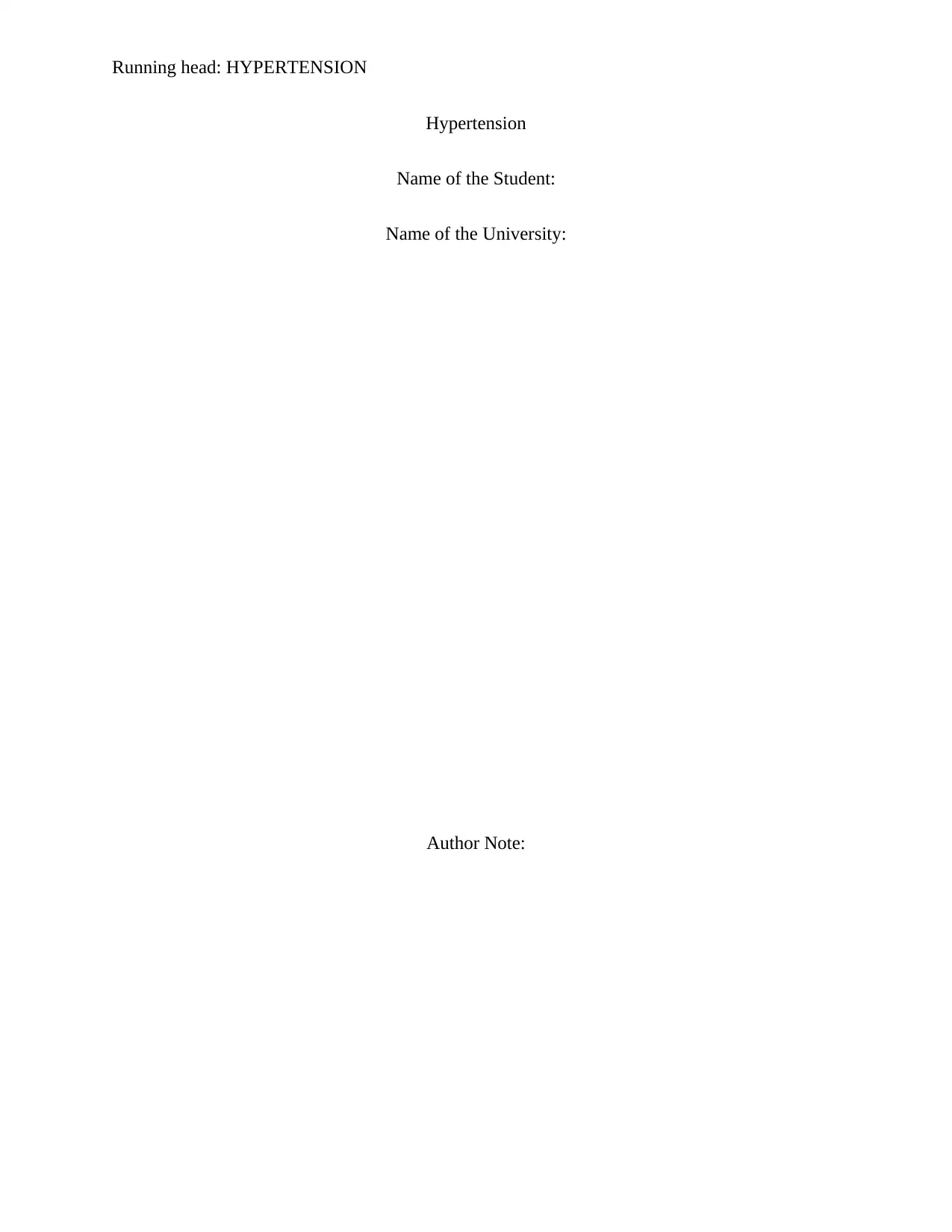
Running head: HYPERTENSION
Hypertension
Name of the Student:
Name of the University:
Author Note:
Hypertension
Name of the Student:
Name of the University:
Author Note:
Paraphrase This Document
Need a fresh take? Get an instant paraphrase of this document with our AI Paraphraser
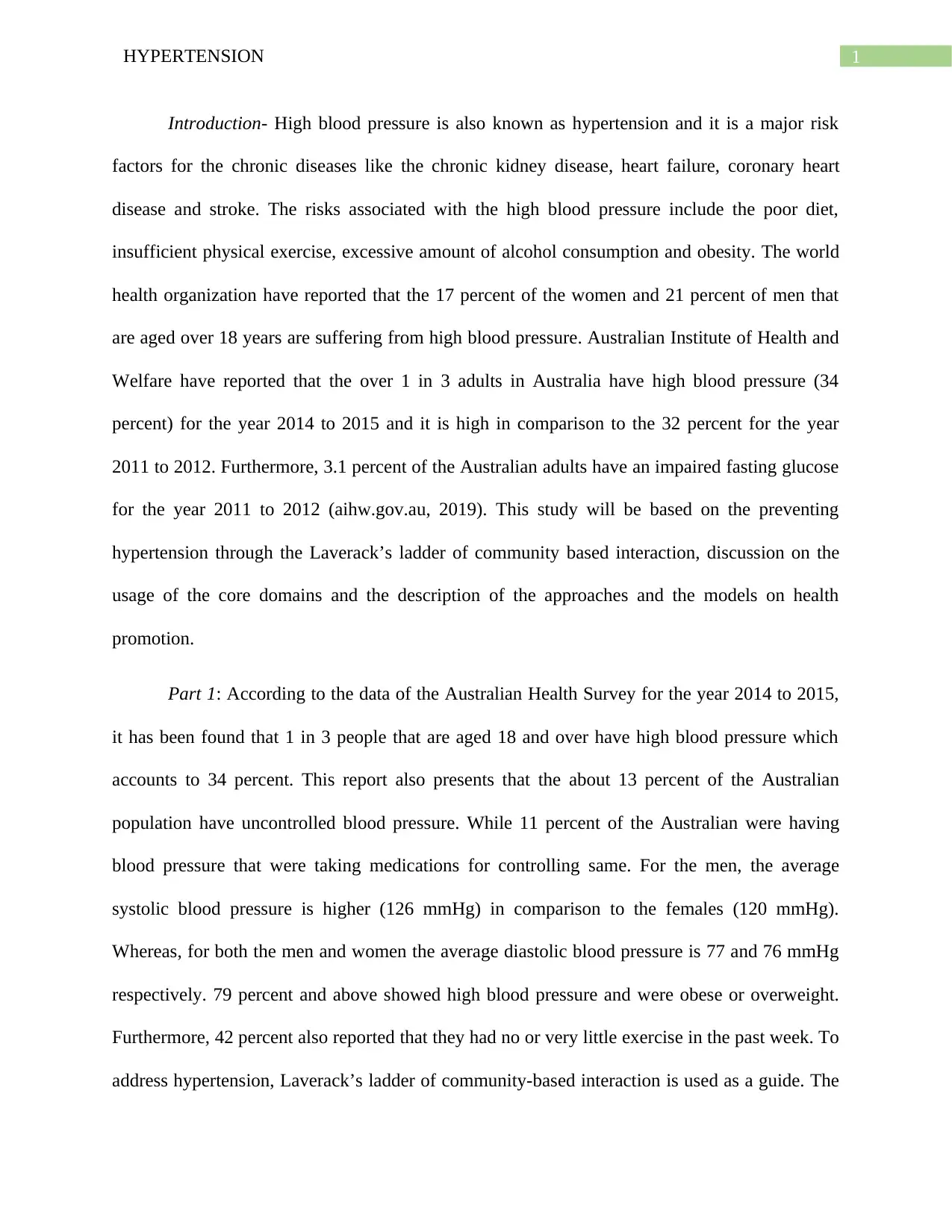
1HYPERTENSION
Introduction- High blood pressure is also known as hypertension and it is a major risk
factors for the chronic diseases like the chronic kidney disease, heart failure, coronary heart
disease and stroke. The risks associated with the high blood pressure include the poor diet,
insufficient physical exercise, excessive amount of alcohol consumption and obesity. The world
health organization have reported that the 17 percent of the women and 21 percent of men that
are aged over 18 years are suffering from high blood pressure. Australian Institute of Health and
Welfare have reported that the over 1 in 3 adults in Australia have high blood pressure (34
percent) for the year 2014 to 2015 and it is high in comparison to the 32 percent for the year
2011 to 2012. Furthermore, 3.1 percent of the Australian adults have an impaired fasting glucose
for the year 2011 to 2012 (aihw.gov.au, 2019). This study will be based on the preventing
hypertension through the Laverack’s ladder of community based interaction, discussion on the
usage of the core domains and the description of the approaches and the models on health
promotion.
Part 1: According to the data of the Australian Health Survey for the year 2014 to 2015,
it has been found that 1 in 3 people that are aged 18 and over have high blood pressure which
accounts to 34 percent. This report also presents that the about 13 percent of the Australian
population have uncontrolled blood pressure. While 11 percent of the Australian were having
blood pressure that were taking medications for controlling same. For the men, the average
systolic blood pressure is higher (126 mmHg) in comparison to the females (120 mmHg).
Whereas, for both the men and women the average diastolic blood pressure is 77 and 76 mmHg
respectively. 79 percent and above showed high blood pressure and were obese or overweight.
Furthermore, 42 percent also reported that they had no or very little exercise in the past week. To
address hypertension, Laverack’s ladder of community-based interaction is used as a guide. The
Introduction- High blood pressure is also known as hypertension and it is a major risk
factors for the chronic diseases like the chronic kidney disease, heart failure, coronary heart
disease and stroke. The risks associated with the high blood pressure include the poor diet,
insufficient physical exercise, excessive amount of alcohol consumption and obesity. The world
health organization have reported that the 17 percent of the women and 21 percent of men that
are aged over 18 years are suffering from high blood pressure. Australian Institute of Health and
Welfare have reported that the over 1 in 3 adults in Australia have high blood pressure (34
percent) for the year 2014 to 2015 and it is high in comparison to the 32 percent for the year
2011 to 2012. Furthermore, 3.1 percent of the Australian adults have an impaired fasting glucose
for the year 2011 to 2012 (aihw.gov.au, 2019). This study will be based on the preventing
hypertension through the Laverack’s ladder of community based interaction, discussion on the
usage of the core domains and the description of the approaches and the models on health
promotion.
Part 1: According to the data of the Australian Health Survey for the year 2014 to 2015,
it has been found that 1 in 3 people that are aged 18 and over have high blood pressure which
accounts to 34 percent. This report also presents that the about 13 percent of the Australian
population have uncontrolled blood pressure. While 11 percent of the Australian were having
blood pressure that were taking medications for controlling same. For the men, the average
systolic blood pressure is higher (126 mmHg) in comparison to the females (120 mmHg).
Whereas, for both the men and women the average diastolic blood pressure is 77 and 76 mmHg
respectively. 79 percent and above showed high blood pressure and were obese or overweight.
Furthermore, 42 percent also reported that they had no or very little exercise in the past week. To
address hypertension, Laverack’s ladder of community-based interaction is used as a guide. The
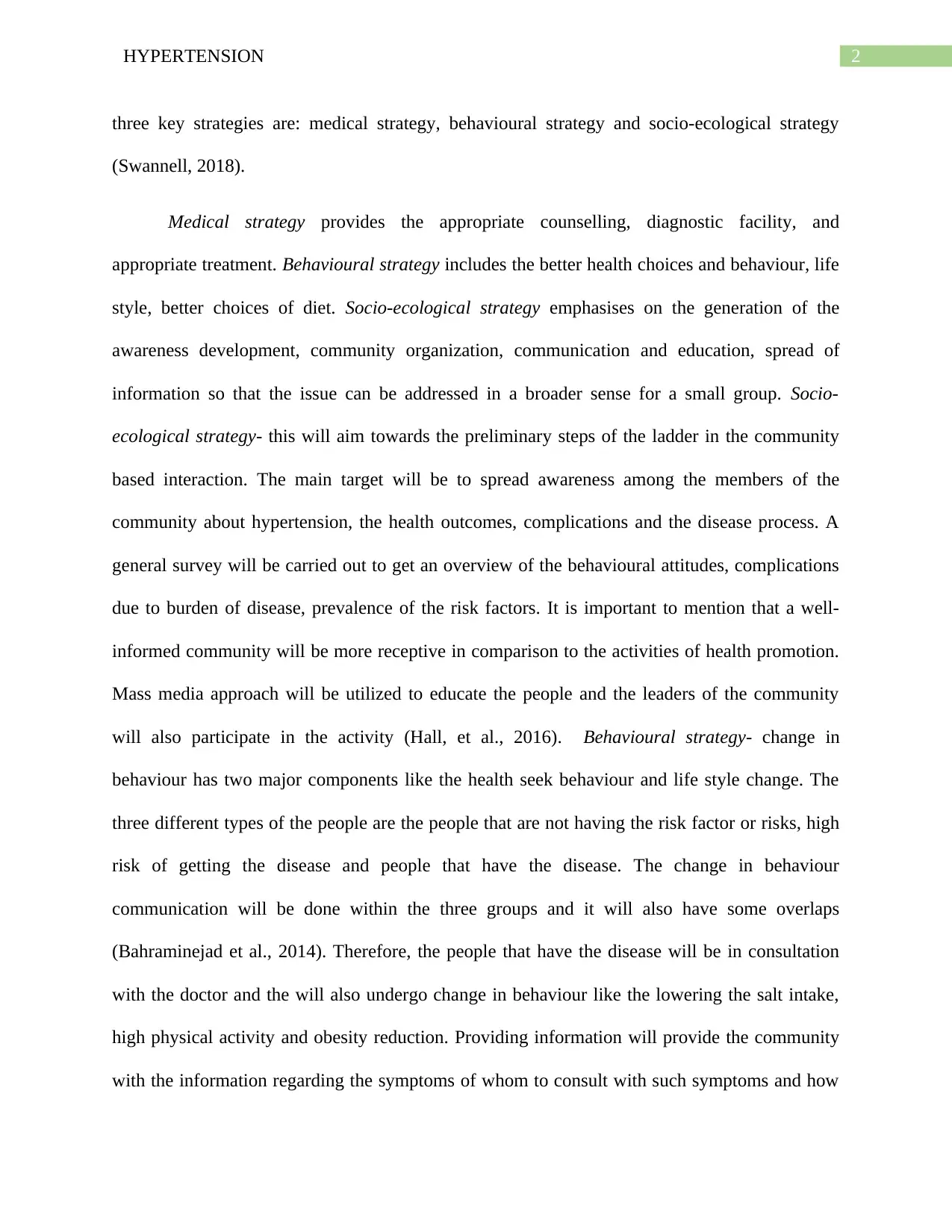
2HYPERTENSION
three key strategies are: medical strategy, behavioural strategy and socio-ecological strategy
(Swannell, 2018).
Medical strategy provides the appropriate counselling, diagnostic facility, and
appropriate treatment. Behavioural strategy includes the better health choices and behaviour, life
style, better choices of diet. Socio-ecological strategy emphasises on the generation of the
awareness development, community organization, communication and education, spread of
information so that the issue can be addressed in a broader sense for a small group. Socio-
ecological strategy- this will aim towards the preliminary steps of the ladder in the community
based interaction. The main target will be to spread awareness among the members of the
community about hypertension, the health outcomes, complications and the disease process. A
general survey will be carried out to get an overview of the behavioural attitudes, complications
due to burden of disease, prevalence of the risk factors. It is important to mention that a well-
informed community will be more receptive in comparison to the activities of health promotion.
Mass media approach will be utilized to educate the people and the leaders of the community
will also participate in the activity (Hall, et al., 2016). Behavioural strategy- change in
behaviour has two major components like the health seek behaviour and life style change. The
three different types of the people are the people that are not having the risk factor or risks, high
risk of getting the disease and people that have the disease. The change in behaviour
communication will be done within the three groups and it will also have some overlaps
(Bahraminejad et al., 2014). Therefore, the people that have the disease will be in consultation
with the doctor and the will also undergo change in behaviour like the lowering the salt intake,
high physical activity and obesity reduction. Providing information will provide the community
with the information regarding the symptoms of whom to consult with such symptoms and how
three key strategies are: medical strategy, behavioural strategy and socio-ecological strategy
(Swannell, 2018).
Medical strategy provides the appropriate counselling, diagnostic facility, and
appropriate treatment. Behavioural strategy includes the better health choices and behaviour, life
style, better choices of diet. Socio-ecological strategy emphasises on the generation of the
awareness development, community organization, communication and education, spread of
information so that the issue can be addressed in a broader sense for a small group. Socio-
ecological strategy- this will aim towards the preliminary steps of the ladder in the community
based interaction. The main target will be to spread awareness among the members of the
community about hypertension, the health outcomes, complications and the disease process. A
general survey will be carried out to get an overview of the behavioural attitudes, complications
due to burden of disease, prevalence of the risk factors. It is important to mention that a well-
informed community will be more receptive in comparison to the activities of health promotion.
Mass media approach will be utilized to educate the people and the leaders of the community
will also participate in the activity (Hall, et al., 2016). Behavioural strategy- change in
behaviour has two major components like the health seek behaviour and life style change. The
three different types of the people are the people that are not having the risk factor or risks, high
risk of getting the disease and people that have the disease. The change in behaviour
communication will be done within the three groups and it will also have some overlaps
(Bahraminejad et al., 2014). Therefore, the people that have the disease will be in consultation
with the doctor and the will also undergo change in behaviour like the lowering the salt intake,
high physical activity and obesity reduction. Providing information will provide the community
with the information regarding the symptoms of whom to consult with such symptoms and how
⊘ This is a preview!⊘
Do you want full access?
Subscribe today to unlock all pages.

Trusted by 1+ million students worldwide
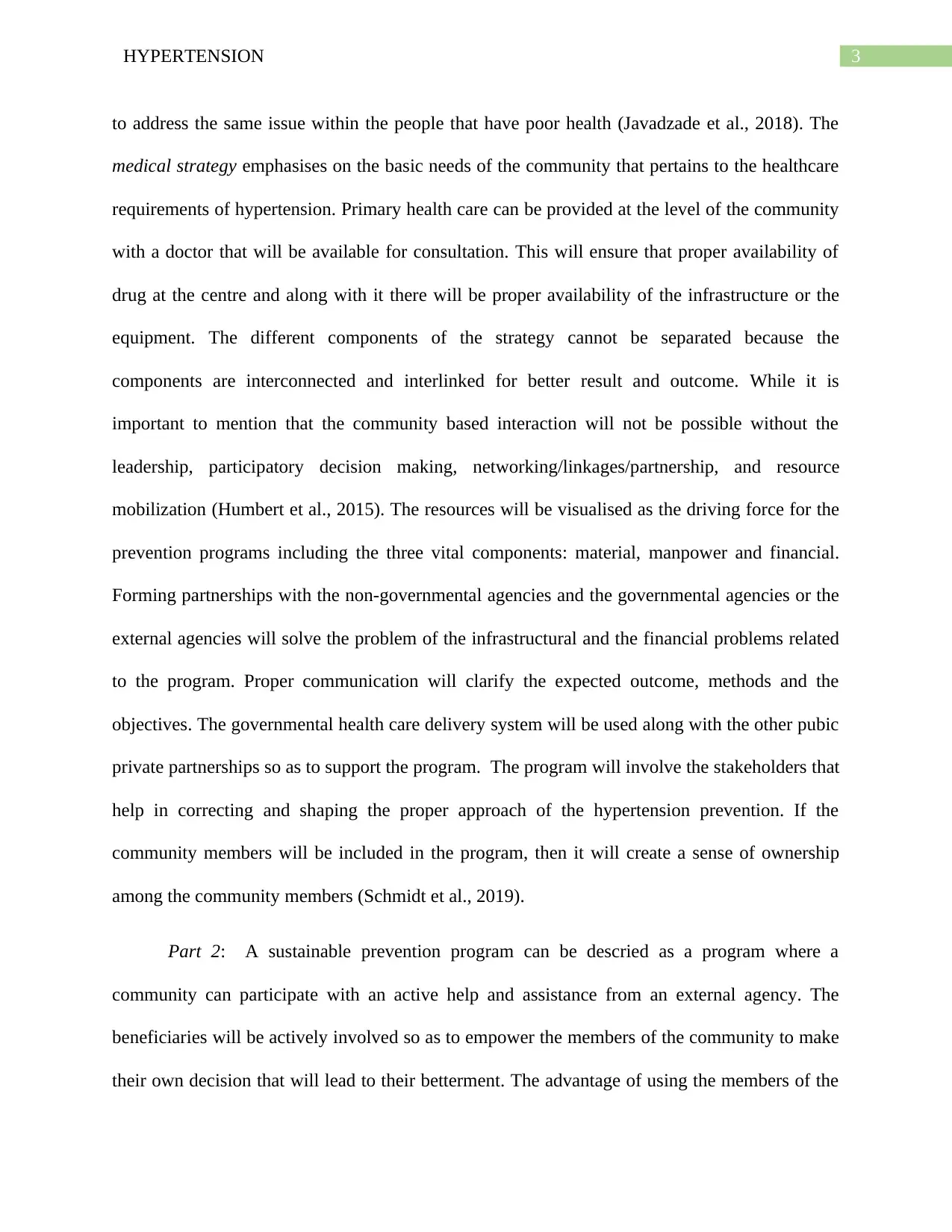
3HYPERTENSION
to address the same issue within the people that have poor health (Javadzade et al., 2018). The
medical strategy emphasises on the basic needs of the community that pertains to the healthcare
requirements of hypertension. Primary health care can be provided at the level of the community
with a doctor that will be available for consultation. This will ensure that proper availability of
drug at the centre and along with it there will be proper availability of the infrastructure or the
equipment. The different components of the strategy cannot be separated because the
components are interconnected and interlinked for better result and outcome. While it is
important to mention that the community based interaction will not be possible without the
leadership, participatory decision making, networking/linkages/partnership, and resource
mobilization (Humbert et al., 2015). The resources will be visualised as the driving force for the
prevention programs including the three vital components: material, manpower and financial.
Forming partnerships with the non-governmental agencies and the governmental agencies or the
external agencies will solve the problem of the infrastructural and the financial problems related
to the program. Proper communication will clarify the expected outcome, methods and the
objectives. The governmental health care delivery system will be used along with the other pubic
private partnerships so as to support the program. The program will involve the stakeholders that
help in correcting and shaping the proper approach of the hypertension prevention. If the
community members will be included in the program, then it will create a sense of ownership
among the community members (Schmidt et al., 2019).
Part 2: A sustainable prevention program can be descried as a program where a
community can participate with an active help and assistance from an external agency. The
beneficiaries will be actively involved so as to empower the members of the community to make
their own decision that will lead to their betterment. The advantage of using the members of the
to address the same issue within the people that have poor health (Javadzade et al., 2018). The
medical strategy emphasises on the basic needs of the community that pertains to the healthcare
requirements of hypertension. Primary health care can be provided at the level of the community
with a doctor that will be available for consultation. This will ensure that proper availability of
drug at the centre and along with it there will be proper availability of the infrastructure or the
equipment. The different components of the strategy cannot be separated because the
components are interconnected and interlinked for better result and outcome. While it is
important to mention that the community based interaction will not be possible without the
leadership, participatory decision making, networking/linkages/partnership, and resource
mobilization (Humbert et al., 2015). The resources will be visualised as the driving force for the
prevention programs including the three vital components: material, manpower and financial.
Forming partnerships with the non-governmental agencies and the governmental agencies or the
external agencies will solve the problem of the infrastructural and the financial problems related
to the program. Proper communication will clarify the expected outcome, methods and the
objectives. The governmental health care delivery system will be used along with the other pubic
private partnerships so as to support the program. The program will involve the stakeholders that
help in correcting and shaping the proper approach of the hypertension prevention. If the
community members will be included in the program, then it will create a sense of ownership
among the community members (Schmidt et al., 2019).
Part 2: A sustainable prevention program can be descried as a program where a
community can participate with an active help and assistance from an external agency. The
beneficiaries will be actively involved so as to empower the members of the community to make
their own decision that will lead to their betterment. The advantage of using the members of the
Paraphrase This Document
Need a fresh take? Get an instant paraphrase of this document with our AI Paraphraser
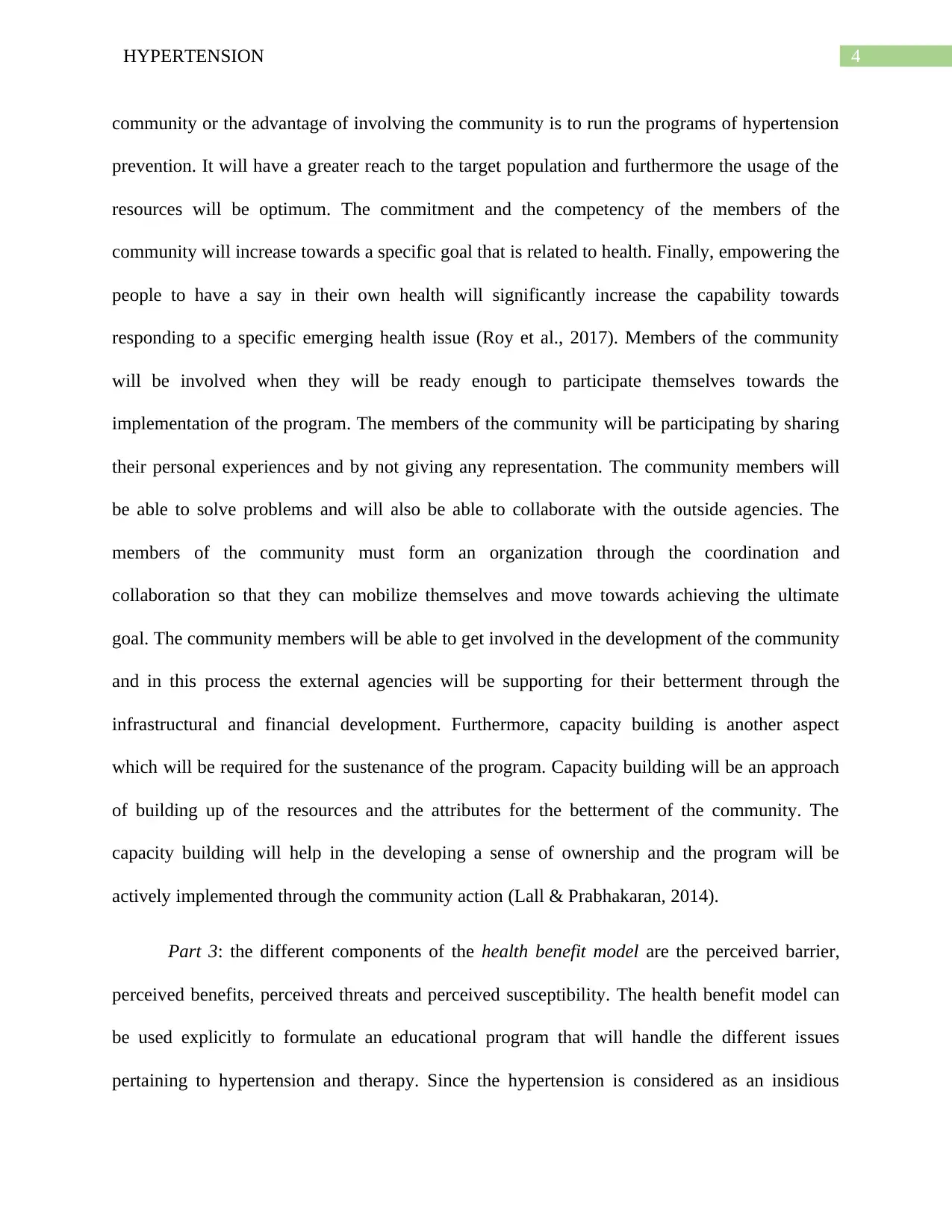
4HYPERTENSION
community or the advantage of involving the community is to run the programs of hypertension
prevention. It will have a greater reach to the target population and furthermore the usage of the
resources will be optimum. The commitment and the competency of the members of the
community will increase towards a specific goal that is related to health. Finally, empowering the
people to have a say in their own health will significantly increase the capability towards
responding to a specific emerging health issue (Roy et al., 2017). Members of the community
will be involved when they will be ready enough to participate themselves towards the
implementation of the program. The members of the community will be participating by sharing
their personal experiences and by not giving any representation. The community members will
be able to solve problems and will also be able to collaborate with the outside agencies. The
members of the community must form an organization through the coordination and
collaboration so that they can mobilize themselves and move towards achieving the ultimate
goal. The community members will be able to get involved in the development of the community
and in this process the external agencies will be supporting for their betterment through the
infrastructural and financial development. Furthermore, capacity building is another aspect
which will be required for the sustenance of the program. Capacity building will be an approach
of building up of the resources and the attributes for the betterment of the community. The
capacity building will help in the developing a sense of ownership and the program will be
actively implemented through the community action (Lall & Prabhakaran, 2014).
Part 3: the different components of the health benefit model are the perceived barrier,
perceived benefits, perceived threats and perceived susceptibility. The health benefit model can
be used explicitly to formulate an educational program that will handle the different issues
pertaining to hypertension and therapy. Since the hypertension is considered as an insidious
community or the advantage of involving the community is to run the programs of hypertension
prevention. It will have a greater reach to the target population and furthermore the usage of the
resources will be optimum. The commitment and the competency of the members of the
community will increase towards a specific goal that is related to health. Finally, empowering the
people to have a say in their own health will significantly increase the capability towards
responding to a specific emerging health issue (Roy et al., 2017). Members of the community
will be involved when they will be ready enough to participate themselves towards the
implementation of the program. The members of the community will be participating by sharing
their personal experiences and by not giving any representation. The community members will
be able to solve problems and will also be able to collaborate with the outside agencies. The
members of the community must form an organization through the coordination and
collaboration so that they can mobilize themselves and move towards achieving the ultimate
goal. The community members will be able to get involved in the development of the community
and in this process the external agencies will be supporting for their betterment through the
infrastructural and financial development. Furthermore, capacity building is another aspect
which will be required for the sustenance of the program. Capacity building will be an approach
of building up of the resources and the attributes for the betterment of the community. The
capacity building will help in the developing a sense of ownership and the program will be
actively implemented through the community action (Lall & Prabhakaran, 2014).
Part 3: the different components of the health benefit model are the perceived barrier,
perceived benefits, perceived threats and perceived susceptibility. The health benefit model can
be used explicitly to formulate an educational program that will handle the different issues
pertaining to hypertension and therapy. Since the hypertension is considered as an insidious
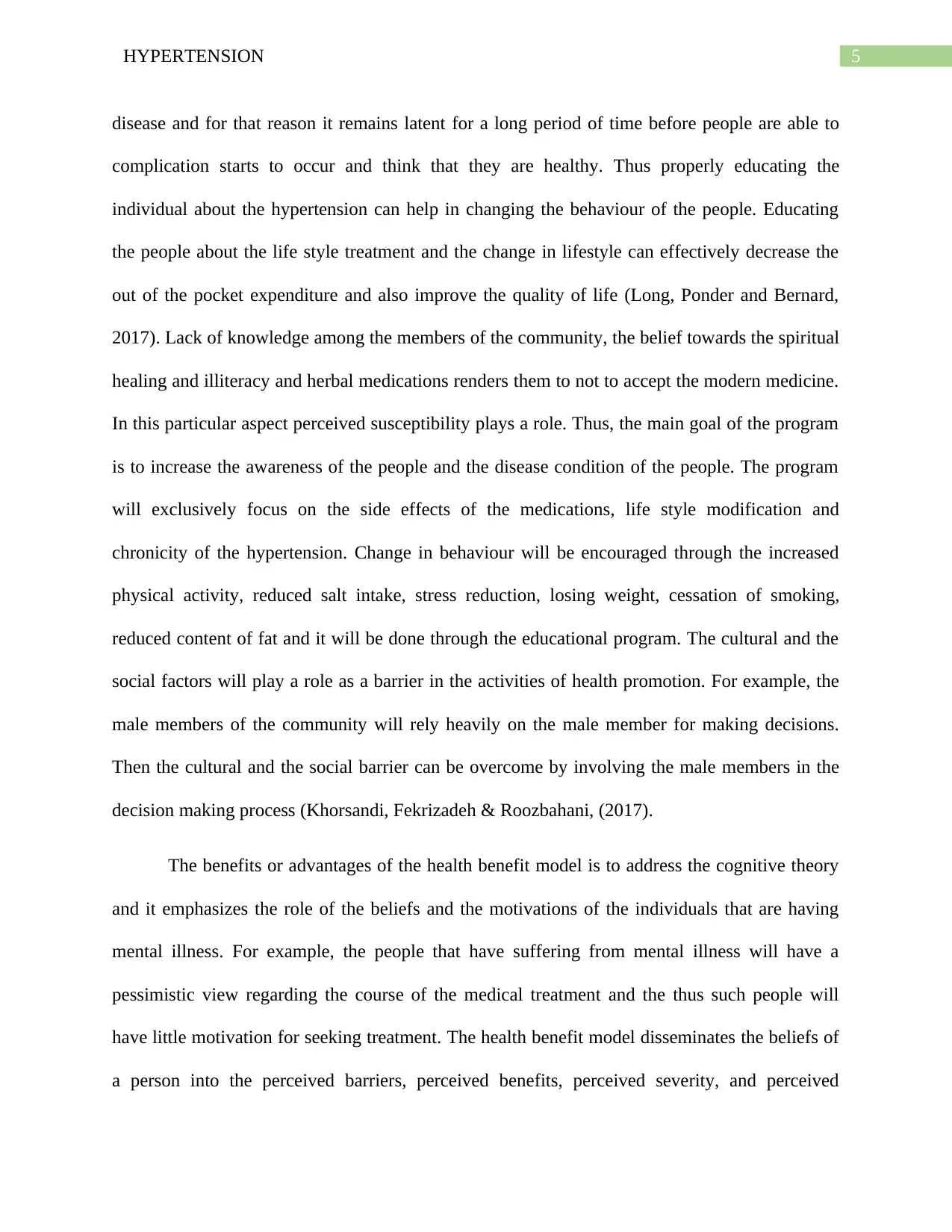
5HYPERTENSION
disease and for that reason it remains latent for a long period of time before people are able to
complication starts to occur and think that they are healthy. Thus properly educating the
individual about the hypertension can help in changing the behaviour of the people. Educating
the people about the life style treatment and the change in lifestyle can effectively decrease the
out of the pocket expenditure and also improve the quality of life (Long, Ponder and Bernard,
2017). Lack of knowledge among the members of the community, the belief towards the spiritual
healing and illiteracy and herbal medications renders them to not to accept the modern medicine.
In this particular aspect perceived susceptibility plays a role. Thus, the main goal of the program
is to increase the awareness of the people and the disease condition of the people. The program
will exclusively focus on the side effects of the medications, life style modification and
chronicity of the hypertension. Change in behaviour will be encouraged through the increased
physical activity, reduced salt intake, stress reduction, losing weight, cessation of smoking,
reduced content of fat and it will be done through the educational program. The cultural and the
social factors will play a role as a barrier in the activities of health promotion. For example, the
male members of the community will rely heavily on the male member for making decisions.
Then the cultural and the social barrier can be overcome by involving the male members in the
decision making process (Khorsandi, Fekrizadeh & Roozbahani, (2017).
The benefits or advantages of the health benefit model is to address the cognitive theory
and it emphasizes the role of the beliefs and the motivations of the individuals that are having
mental illness. For example, the people that have suffering from mental illness will have a
pessimistic view regarding the course of the medical treatment and the thus such people will
have little motivation for seeking treatment. The health benefit model disseminates the beliefs of
a person into the perceived barriers, perceived benefits, perceived severity, and perceived
disease and for that reason it remains latent for a long period of time before people are able to
complication starts to occur and think that they are healthy. Thus properly educating the
individual about the hypertension can help in changing the behaviour of the people. Educating
the people about the life style treatment and the change in lifestyle can effectively decrease the
out of the pocket expenditure and also improve the quality of life (Long, Ponder and Bernard,
2017). Lack of knowledge among the members of the community, the belief towards the spiritual
healing and illiteracy and herbal medications renders them to not to accept the modern medicine.
In this particular aspect perceived susceptibility plays a role. Thus, the main goal of the program
is to increase the awareness of the people and the disease condition of the people. The program
will exclusively focus on the side effects of the medications, life style modification and
chronicity of the hypertension. Change in behaviour will be encouraged through the increased
physical activity, reduced salt intake, stress reduction, losing weight, cessation of smoking,
reduced content of fat and it will be done through the educational program. The cultural and the
social factors will play a role as a barrier in the activities of health promotion. For example, the
male members of the community will rely heavily on the male member for making decisions.
Then the cultural and the social barrier can be overcome by involving the male members in the
decision making process (Khorsandi, Fekrizadeh & Roozbahani, (2017).
The benefits or advantages of the health benefit model is to address the cognitive theory
and it emphasizes the role of the beliefs and the motivations of the individuals that are having
mental illness. For example, the people that have suffering from mental illness will have a
pessimistic view regarding the course of the medical treatment and the thus such people will
have little motivation for seeking treatment. The health benefit model disseminates the beliefs of
a person into the perceived barriers, perceived benefits, perceived severity, and perceived
⊘ This is a preview!⊘
Do you want full access?
Subscribe today to unlock all pages.

Trusted by 1+ million students worldwide
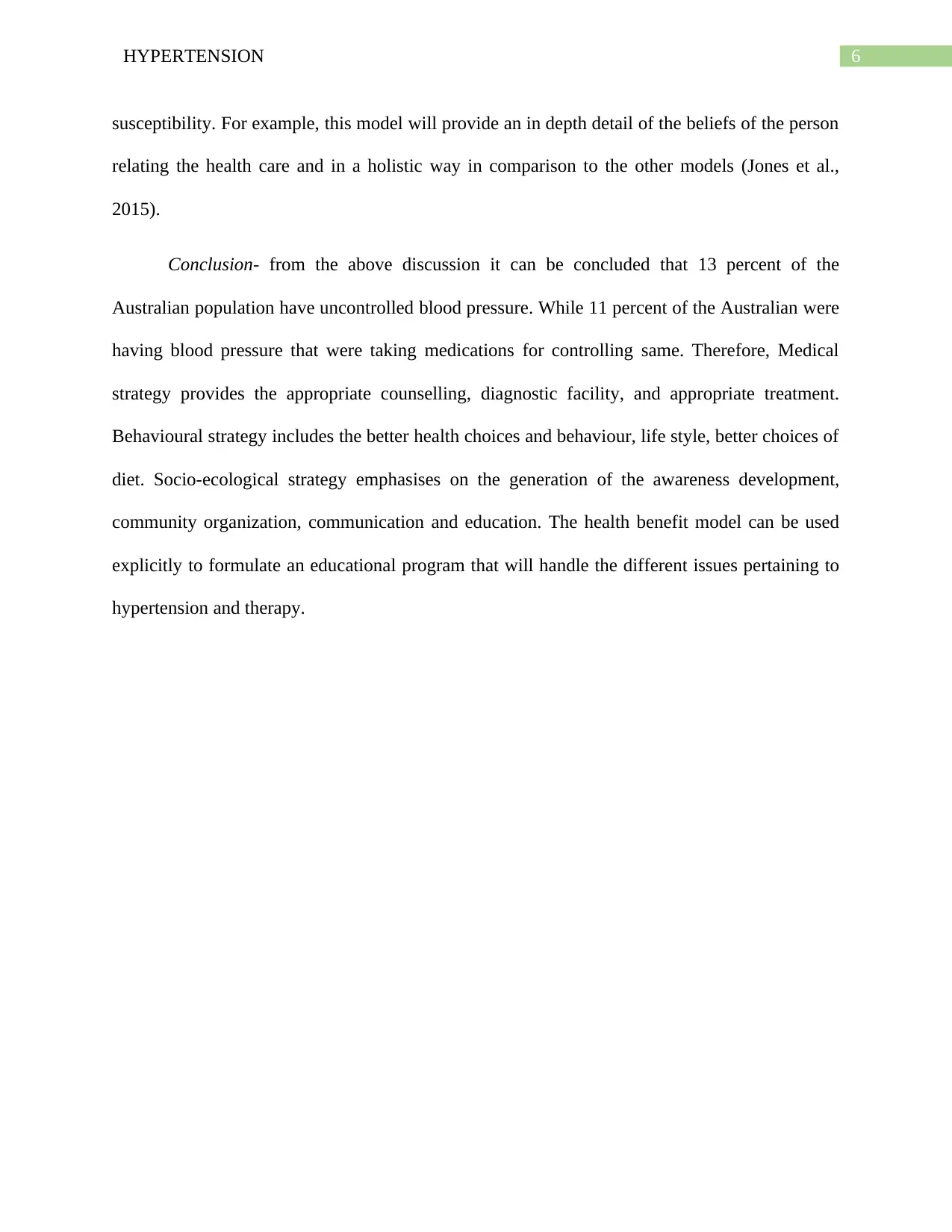
6HYPERTENSION
susceptibility. For example, this model will provide an in depth detail of the beliefs of the person
relating the health care and in a holistic way in comparison to the other models (Jones et al.,
2015).
Conclusion- from the above discussion it can be concluded that 13 percent of the
Australian population have uncontrolled blood pressure. While 11 percent of the Australian were
having blood pressure that were taking medications for controlling same. Therefore, Medical
strategy provides the appropriate counselling, diagnostic facility, and appropriate treatment.
Behavioural strategy includes the better health choices and behaviour, life style, better choices of
diet. Socio-ecological strategy emphasises on the generation of the awareness development,
community organization, communication and education. The health benefit model can be used
explicitly to formulate an educational program that will handle the different issues pertaining to
hypertension and therapy.
susceptibility. For example, this model will provide an in depth detail of the beliefs of the person
relating the health care and in a holistic way in comparison to the other models (Jones et al.,
2015).
Conclusion- from the above discussion it can be concluded that 13 percent of the
Australian population have uncontrolled blood pressure. While 11 percent of the Australian were
having blood pressure that were taking medications for controlling same. Therefore, Medical
strategy provides the appropriate counselling, diagnostic facility, and appropriate treatment.
Behavioural strategy includes the better health choices and behaviour, life style, better choices of
diet. Socio-ecological strategy emphasises on the generation of the awareness development,
community organization, communication and education. The health benefit model can be used
explicitly to formulate an educational program that will handle the different issues pertaining to
hypertension and therapy.
Paraphrase This Document
Need a fresh take? Get an instant paraphrase of this document with our AI Paraphraser
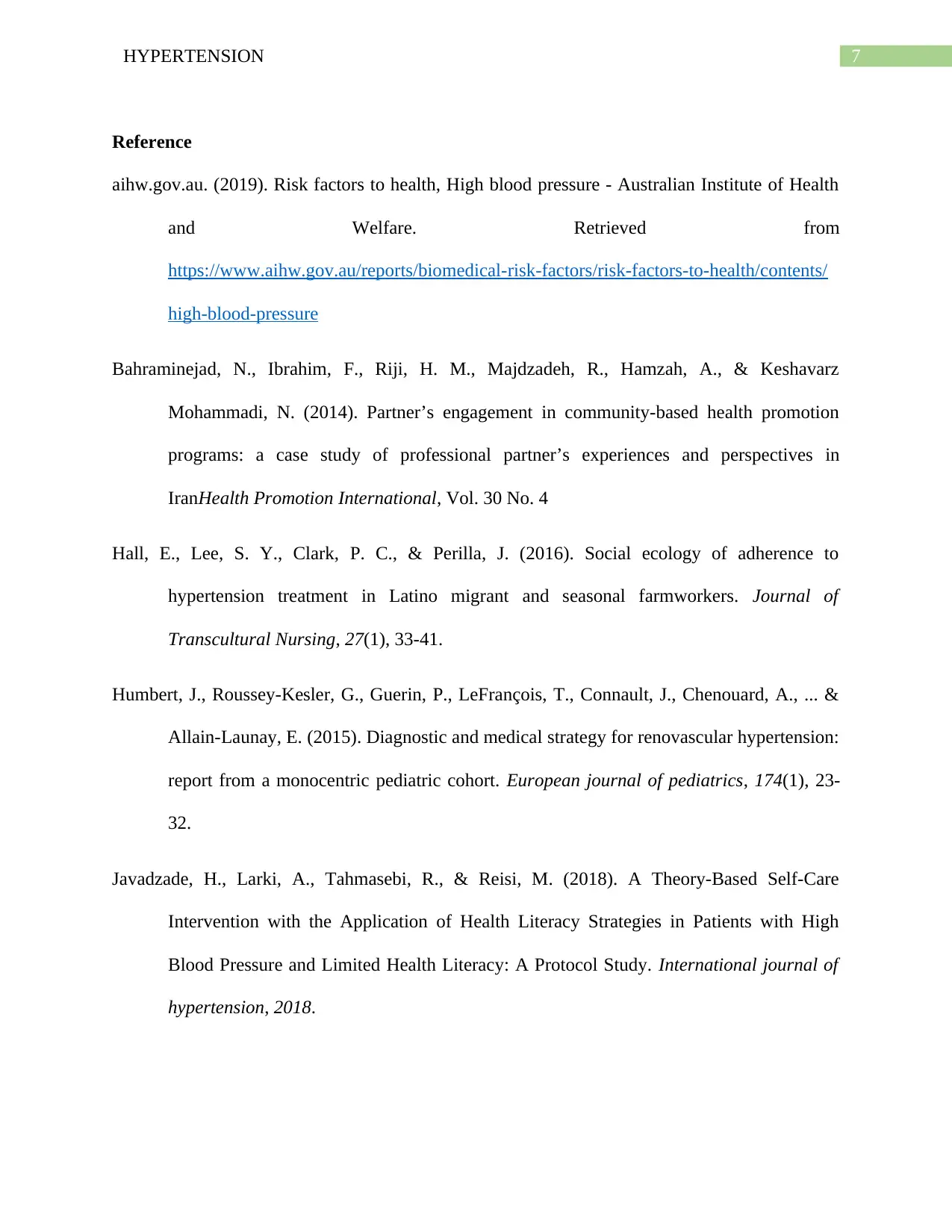
7HYPERTENSION
Reference
aihw.gov.au. (2019). Risk factors to health, High blood pressure - Australian Institute of Health
and Welfare. Retrieved from
https://www.aihw.gov.au/reports/biomedical-risk-factors/risk-factors-to-health/contents/
high-blood-pressure
Bahraminejad, N., Ibrahim, F., Riji, H. M., Majdzadeh, R., Hamzah, A., & Keshavarz
Mohammadi, N. (2014). Partner’s engagement in community-based health promotion
programs: a case study of professional partner’s experiences and perspectives in
IranHealth Promotion International, Vol. 30 No. 4
Hall, E., Lee, S. Y., Clark, P. C., & Perilla, J. (2016). Social ecology of adherence to
hypertension treatment in Latino migrant and seasonal farmworkers. Journal of
Transcultural Nursing, 27(1), 33-41.
Humbert, J., Roussey-Kesler, G., Guerin, P., LeFrançois, T., Connault, J., Chenouard, A., ... &
Allain-Launay, E. (2015). Diagnostic and medical strategy for renovascular hypertension:
report from a monocentric pediatric cohort. European journal of pediatrics, 174(1), 23-
32.
Javadzade, H., Larki, A., Tahmasebi, R., & Reisi, M. (2018). A Theory-Based Self-Care
Intervention with the Application of Health Literacy Strategies in Patients with High
Blood Pressure and Limited Health Literacy: A Protocol Study. International journal of
hypertension, 2018.
Reference
aihw.gov.au. (2019). Risk factors to health, High blood pressure - Australian Institute of Health
and Welfare. Retrieved from
https://www.aihw.gov.au/reports/biomedical-risk-factors/risk-factors-to-health/contents/
high-blood-pressure
Bahraminejad, N., Ibrahim, F., Riji, H. M., Majdzadeh, R., Hamzah, A., & Keshavarz
Mohammadi, N. (2014). Partner’s engagement in community-based health promotion
programs: a case study of professional partner’s experiences and perspectives in
IranHealth Promotion International, Vol. 30 No. 4
Hall, E., Lee, S. Y., Clark, P. C., & Perilla, J. (2016). Social ecology of adherence to
hypertension treatment in Latino migrant and seasonal farmworkers. Journal of
Transcultural Nursing, 27(1), 33-41.
Humbert, J., Roussey-Kesler, G., Guerin, P., LeFrançois, T., Connault, J., Chenouard, A., ... &
Allain-Launay, E. (2015). Diagnostic and medical strategy for renovascular hypertension:
report from a monocentric pediatric cohort. European journal of pediatrics, 174(1), 23-
32.
Javadzade, H., Larki, A., Tahmasebi, R., & Reisi, M. (2018). A Theory-Based Self-Care
Intervention with the Application of Health Literacy Strategies in Patients with High
Blood Pressure and Limited Health Literacy: A Protocol Study. International journal of
hypertension, 2018.
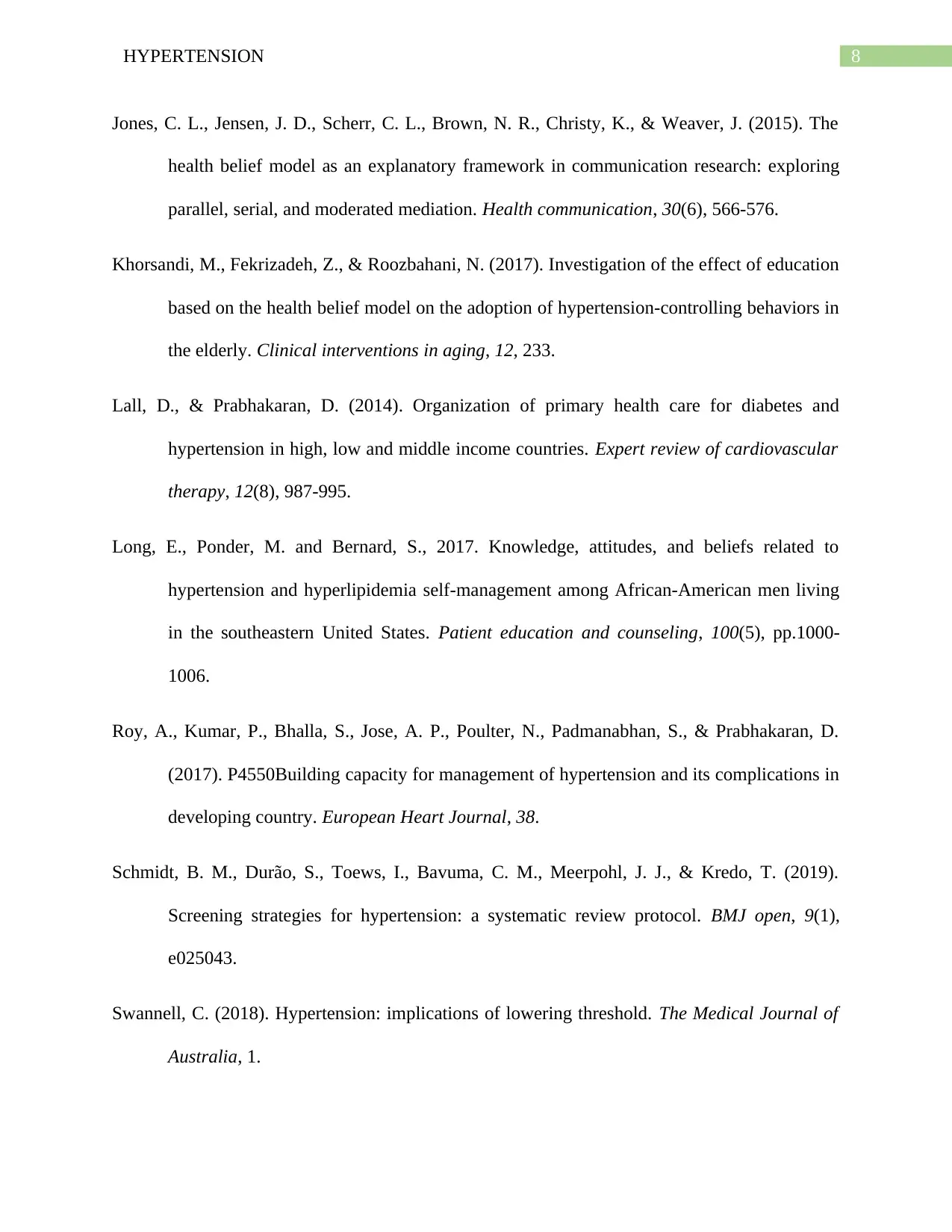
8HYPERTENSION
Jones, C. L., Jensen, J. D., Scherr, C. L., Brown, N. R., Christy, K., & Weaver, J. (2015). The
health belief model as an explanatory framework in communication research: exploring
parallel, serial, and moderated mediation. Health communication, 30(6), 566-576.
Khorsandi, M., Fekrizadeh, Z., & Roozbahani, N. (2017). Investigation of the effect of education
based on the health belief model on the adoption of hypertension-controlling behaviors in
the elderly. Clinical interventions in aging, 12, 233.
Lall, D., & Prabhakaran, D. (2014). Organization of primary health care for diabetes and
hypertension in high, low and middle income countries. Expert review of cardiovascular
therapy, 12(8), 987-995.
Long, E., Ponder, M. and Bernard, S., 2017. Knowledge, attitudes, and beliefs related to
hypertension and hyperlipidemia self-management among African-American men living
in the southeastern United States. Patient education and counseling, 100(5), pp.1000-
1006.
Roy, A., Kumar, P., Bhalla, S., Jose, A. P., Poulter, N., Padmanabhan, S., & Prabhakaran, D.
(2017). P4550Building capacity for management of hypertension and its complications in
developing country. European Heart Journal, 38.
Schmidt, B. M., Durão, S., Toews, I., Bavuma, C. M., Meerpohl, J. J., & Kredo, T. (2019).
Screening strategies for hypertension: a systematic review protocol. BMJ open, 9(1),
e025043.
Swannell, C. (2018). Hypertension: implications of lowering threshold. The Medical Journal of
Australia, 1.
Jones, C. L., Jensen, J. D., Scherr, C. L., Brown, N. R., Christy, K., & Weaver, J. (2015). The
health belief model as an explanatory framework in communication research: exploring
parallel, serial, and moderated mediation. Health communication, 30(6), 566-576.
Khorsandi, M., Fekrizadeh, Z., & Roozbahani, N. (2017). Investigation of the effect of education
based on the health belief model on the adoption of hypertension-controlling behaviors in
the elderly. Clinical interventions in aging, 12, 233.
Lall, D., & Prabhakaran, D. (2014). Organization of primary health care for diabetes and
hypertension in high, low and middle income countries. Expert review of cardiovascular
therapy, 12(8), 987-995.
Long, E., Ponder, M. and Bernard, S., 2017. Knowledge, attitudes, and beliefs related to
hypertension and hyperlipidemia self-management among African-American men living
in the southeastern United States. Patient education and counseling, 100(5), pp.1000-
1006.
Roy, A., Kumar, P., Bhalla, S., Jose, A. P., Poulter, N., Padmanabhan, S., & Prabhakaran, D.
(2017). P4550Building capacity for management of hypertension and its complications in
developing country. European Heart Journal, 38.
Schmidt, B. M., Durão, S., Toews, I., Bavuma, C. M., Meerpohl, J. J., & Kredo, T. (2019).
Screening strategies for hypertension: a systematic review protocol. BMJ open, 9(1),
e025043.
Swannell, C. (2018). Hypertension: implications of lowering threshold. The Medical Journal of
Australia, 1.
⊘ This is a preview!⊘
Do you want full access?
Subscribe today to unlock all pages.

Trusted by 1+ million students worldwide
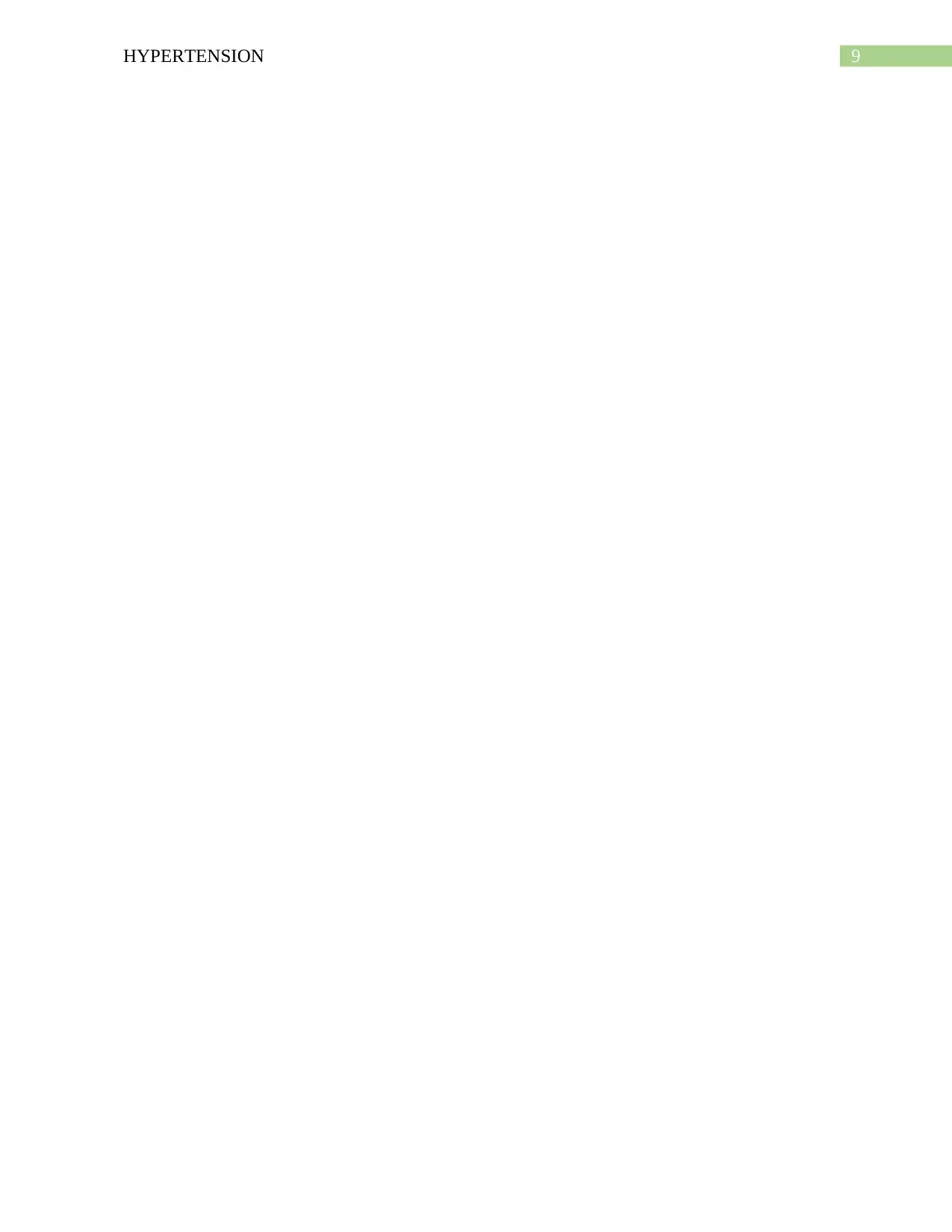
9HYPERTENSION
1 out of 10
Related Documents
Your All-in-One AI-Powered Toolkit for Academic Success.
+13062052269
info@desklib.com
Available 24*7 on WhatsApp / Email
![[object Object]](/_next/static/media/star-bottom.7253800d.svg)
Unlock your academic potential
Copyright © 2020–2025 A2Z Services. All Rights Reserved. Developed and managed by ZUCOL.





